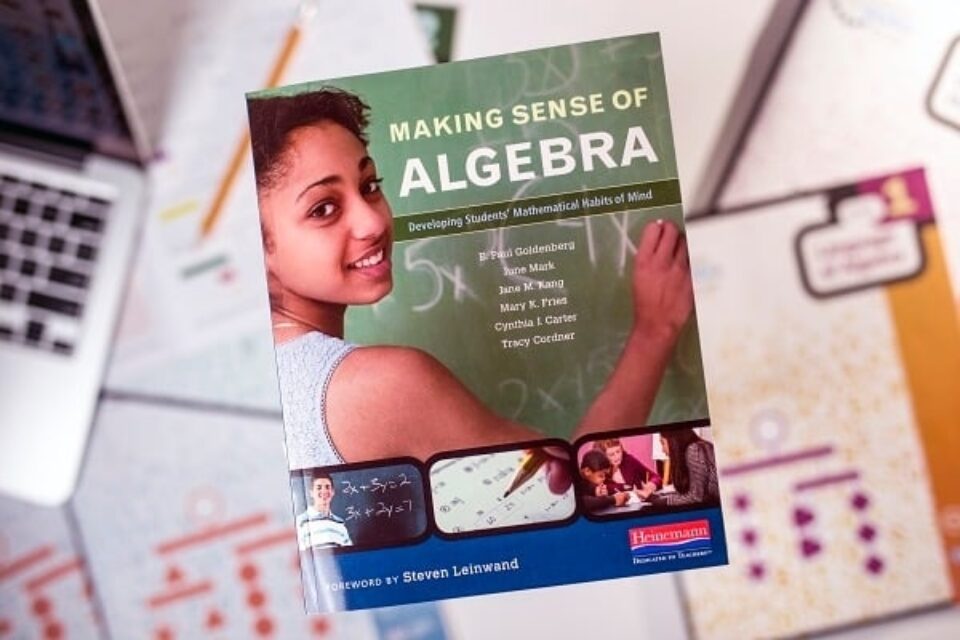
Imagine helping your students expect math to make sense.
In Making Sense of Algebra, Paul Goldenberg, June Mark, and their colleagues look carefully at how our students think about mathematics. They explore five “Habits of Mind” that focus not just on the results of mathematical thinking, but on how proficient students do that thinking.
In today’s blog, which is the second of five adapted from the book, the authors talk about the habit of puzzling and persevering.
Habits of Mind: Puzzling and Persevering
By Paul Goldenberg, June Mark, Jane Kang, Mary Fries, Cynthia Carter, and Tracy Cordner
Seeing mathematics as a collection of magic spells that “just work” divorces it from common sense. One of our main goals—in the problems and projects we assign and in the way we conduct ourselves as teachers—is to lead students to expect mathematics to make sense, to feel coherent and not arbitrary, and to have understandable reasons behind its facts and methods. Building the puzzling and persevering habit of mind means engineering our instruction so that students look for that logic and coherence in each new situation they encounter, treating new problems as puzzles, looking for strategic starting places, and fitting the clues together.
The problems we encounter in the real world—our work life, family life, and personal health—don’t tell us which parts of our prior knowledge to recall and use. They rarely even tell us exactly what question we must ask or answer, and they almost never tell us where to begin. To survive and succeed, we must figure out the right question to be asking and what additional information we might need, what relevant experience we have, and where to start. And we must have enough stamina to continue even when progress is hard (or imperceptible) and enough flexibility to try alternative approaches when progress seems too hard.
The same applies to the real-life problems of children, problems like learning to talk, ride a bicycle, play a sport, handle difficulties with friends, and so on. What makes a problem “real” is not the context. A good puzzle is more real to a child’s “real world” than figuring out how much paint is needed for a wall; it is also a better model of the nature of the thinking that goes with real problems, because the first task in a puzzle of any kind is to figure out where to start. A satisfying puzzle is one that you don’t know how to solve at first but can figure out. Newer assessments, and even the familiar older ones like college entrance exams, often design deliberately offbeat problems, for which students must (in the words of the Common Core State Standards) “[explain] to themselves the meaning,” combine and sensibly string together knowledge they’ve gathered in various places (e.g., in different chapters!), and “[look] for entry points to its solution.”
Consider a problem type that we playfully call “tailless” word problems. You can create tailless problems yourself from any word problem you find worth thinking about, by omitting the question at the tail end. For example, you might start with a problem like the following, typical of many algebra texts:
Right now, fewer than a dozen bicycles and tricycles are in the local playground. Altogether, there are at least 17 wheels. If v represents the number of vehicles and w represents the number of wheels, which system of equations describes this situation?
A “tailless” version of this problem would contain only the first two sentences, omitting the question that begins with “If v represents . . .” Instead, it would pose students one of two more generic questions: What can you say for sure about the situation? or What questions can you pose that might be answerable from this information
At first, tailless problems are likely to be unfamiliar, and students won’t be quick to respond.
Many responses are possible. Of course, a student could offer a question aimed at the same (presumed) goal of the original problem: How can you describe the situation using algebraic equations or inequalities? But there are other possibilities, like these:
- What is the largest (or smallest) number of wheels there can be?
- What is the largest (or smallest) number of vehicles?
- If we knew that there were exactly 17 wheels, could we figure out, for sure, how many bicycles there were?
- If we were told exactly how many wheels there were, what more could we figure out?
- Is it possible to have exactly 12 (or 13 or 25) as many vehicles as wheels?
The answers to some of those questions are “trivial,” explicitly given in the problem statement; others need some figuring out; and at least one leads to a general challenge.
- Instead of questions, a student could make statements. Things that you could say for sure include:
- If we have exactly 17 wheels, then there must be at least 1 bicycle and at least 1 tricycle.
- If there were exactly 18 wheels, there could be all bicycles or all tricycles!
- There can’t be more than 33 wheels.
- There can’t be less than 17 wheels.
- There must be at least 6 vehicles.
The statement “There can’t be less than 17 wheels” may feel trivial—it is more of a restatement of the given than a deduction—but even statements like that, especially early in learning how to do this kind of thinking, should not be discounted. Think of the work involved in understanding that “it is at least 17” means that it can be 17 and that it can be greater—expressed as w ≥ 17 symbolically—but it cannot be less.
Problem situations can be quite simple and still worthy of analysis in this way. For example, “Kayla has exactly 28¢ in her pocket. What can you say for sure about the coins in her pocket?”
At first, tailless problems are likely to be unfamiliar, and students won’t be quick to respond. They may withhold good ideas, thinking that there is a “right answer” you are waiting for that they don’t know. They may feel that their ideas are not worth saying or sound trivial. You want to encourage a variety of responses:
- Kayla could have 2 dimes and 8 pennies.
- Kayla could have 28 pennies.
- Kayla could have 5 nickels and 3 pennies.
- Kayla must have some pennies.
- Kayla must have at least 4 coins.
As in the previous example, even a response like “Kayla has more than a quarter,” which seems trivial, is important to accept, partly because it helps free students to make observations—the goal is mathematical correctness, not profundity—but also because, in the right context, this is not trivial at all. If some life event requires one to have 25¢, then observing that 28¢ is more than enough is a completely legitimate conclusion. There are many good responses to this problem. The goal is not for students to get any particular one but to derive what they can from the given information, to reason with what they know, and, especially importantly—a skill grown over time, not all at once—to notice how many different sensible deductions can be made and to be creative at finding them. These challenges—developing good questions and starting with what one knows and figuring out what else can be known—ask learners for deeper analysis than typical problems do. They are also more like real-life situations, in which we have incomplete information, are left to find our own questions, and must find or invent our own methods.
♦ ♦ ♦ ♦
 Paul Goldenberg, June Mark, Jane Kang, Mary Fries, and Tracy Cordner work in the Learning and Teaching Division at Education Development Center (EDC), a non-profit organization that designs, implements, and evaluates programs to improve education, health, and economic opportunity worldwide. Cynthia Carter is a mathematics teacher at The Rashi School in Massachusetts.
Paul Goldenberg, June Mark, Jane Kang, Mary Fries, and Tracy Cordner work in the Learning and Teaching Division at Education Development Center (EDC), a non-profit organization that designs, implements, and evaluates programs to improve education, health, and economic opportunity worldwide. Cynthia Carter is a mathematics teacher at The Rashi School in Massachusetts.


